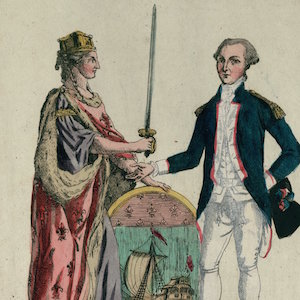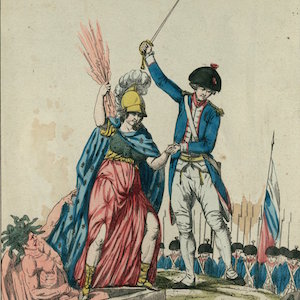Government

Meeting of the Emperors at Tilsit
In July 1807, Napoleon and Alexander agreed to cooperate. Napoleon used this strategy to prevent his enemies from forming an alliance against him.

The Royal and Imperial Family of Napoleon
The remainder of the text on this image reads: Emperor of the French, King of Italy, and Protector of the Confederation of the Rhine. The military flags make clear the connection between military conquest and imperial glory.

Retreat from Russia
There was not much to celebrate in the Russian campaign, especially once the retreat from Moscow began. Print depicting the horrific conditions and loses suffered by the French army as it retreated from Moscow in the winter of 1812.

Triumph of the Year 1813
Napoleon’s efforts to dominate central Europe kindled a huge reaction, as national feelings soared among the many ethnic groups inhabiting the area. While these feelings would eventually lead to great internal conflicts, at first they were focused on francophobia and hostility to Napoleon.

Napoleon Is Unable to Digest Leipzig
After the defeat in Russia, with renewed allied forces arrayed against him, Napoleon prepared once again to defend France. Yet in 1813 at Leipzig, the Emperor was defeated. This allowed the allies to press a successful campaign, leading to the surrender in 1814.

Congress of Vienna
The treaty in the spring of 1814 had accepted Napoleon’s surrender, but a general meeting of European countries convened to settle broader issues of a postrevolutionary era.

The Death of Napoleon on St. Helena
Even in death Napoleon was controversial. Many questions surrounded his death: Was he poisoned? His hair had high levels of arsenic in it. Did he have stomach cancer? He certainly had stomach ulcers and suffered from severe intestinal pain and frequent vomiting.

Lafayette Receives the City’s 'Sword for the Defense of Liberty'
During the Revolution the most visible connection between America and France was Lafayette, who had volunteered for service in the American Revolution and had been mentored by Washington and Jefferson.

The French Nation Defeats Despotism
Here Lafayette’s role is praised. A warlike liberty stands with him over a defeated despotism at his feet. Revolutionaries often represented despotism as a multi-headed monster.

Burning the Guardhouse on the Pont Neuf
This retrospective shows that early in the French Revolution targets were often economic. This should be no surprise as the populace had a long tradition of taking the law into its own hands to rectify what they saw as injustices.